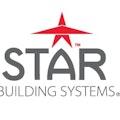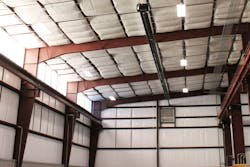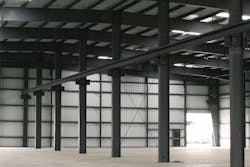When planning a new building, one of the first decisions made is size. Assuming the land is available, most owners will ask themselves how much space do I really need? But, perhaps the right question is, how much space do I need now, and how much will I need in the future?
Metal building systems are often selected for large-sized structures, and with good reason. The framing design makes clear-span widths up to about 200 feet more cost-effective. Length can be virtually infinite because frames can be repeated as many times as there is space available on the site. A barn might need only five bays, but a strip mall or a factory with a long assembly line might need 100. There is no inherent limit to the number of bays that can be built.
If you’re planning a building, and think that your future needs may be larger than your current ones, it’s wise to site the structure so that it can be extended later, leaving available land in the direction where you would want to expand.
There are actually three good ways to extend a metal building system after initial construction. The best way is to plan expansion into the initial design in terms of the engineering of the load-bearing frames. A bay is defined by two frames. Each frame supports half the load of the roof of that bay. Since there are adjacent bays too, each frame is designed to be strong enough to support the roof on both sides: half of Bay A and half of Bay B, etc. The frame at the end of the structure, however, only has to support roof weight from one side. To reduce steel and save money, end frames are usually made lighter, since they support less load.
However, if future expansion is a possibility, the end frames can be constructed to bear a full bay load. Then, when it’s time to expand, that end frame is ready to become a middle frame, with roof load on both sides. All that has to be done is to remove the end wall and erect additional frames. A good builder would be wise to point out this option to any prospective client. (Note: If the Building Code has changed since the original building was built, the expandable end frame could possibly require modification.)
Even if the expansion option is not built into the design, and the usual lighter-duty end-frames are used in initial construction, the building can still be expanded later, but it will cost you a little more.
One way is to replace the end-frames with full-load frames. It would require removing parts of the wall, roof panels, and secondary steel that are attached to the existing frame. Theoretically, the rest of the structure can be preserved and remain.
Another option is to remove the end wall and beef up the existing end-frame with additional steel. This requires less disturbance of the existing structure, but it may not be as efficient. The cost difference between the two retrofit options would have to be determined on a case-by-case basis.
If future expansion is a real possibility, the best choice is to build the option into the initial design. The building will cost slightly more, but it will save time and money on the later extension. If you have the land, and the ambition, it’s worth considering.
For more information on Star Building Systems, visit www.starbuildings.com.
About the Author

Star Building Systems
Founded in 1927, Star Building Systems has seen and done it all, from supplying tool sheds for oil derrick drilling sites in the early oil boom days to hangar buildings during World War II. We set the industry standard for innovation and technology. Most importantly, we have the best builders in the business.


